This article was published in Scientific American’s former blog network and reflects the views of the author, not necessarily those of Scientific American
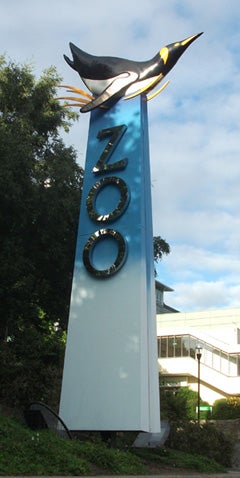
Welcome to Edinburgh Zoo. Even the sign outside is awesome. Credit: DARREN NAISH
Here’s a new thing I’ve been thinking about doing for a while. I generally enjoy going to zoos and do so whenever opportunity arises. I take lots of photos, and I always come away with thoughts about the animals I’ve seen and about the zoo and what it does in general. I’ve therefore decided to start a sort of ‘zoo review’ series of articles in which I hope to provide useful and hopefully interesting thoughts on zoos and their contents. And we start this new endeavour with Edinburgh Zoo in Scotland (UK), a zoo fresh on my mind since I visited while working in Scotland just a few days ago. Edinburgh Zoo is one of my favourites, and I mostly have very good things to say about it.
Edinburgh Zoo was opened in 1913 and is situated in somewhat hilly terrain that provides it with grand views of the city (you would definitely be advised against tackling certain parts of the zoo if of limited mobility). While outside the main part of the city, it’s highly accessible thanks to direct bus links that travel regularly from many places within the city centre to right outside the zoo’s front entrance. The entrance fee is typical (c £20 including voluntary donation).
On supporting science journalism
If you're enjoying this article, consider supporting our award-winning journalism by subscribing. By purchasing a subscription you are helping to ensure the future of impactful stories about the discoveries and ideas shaping our world today.
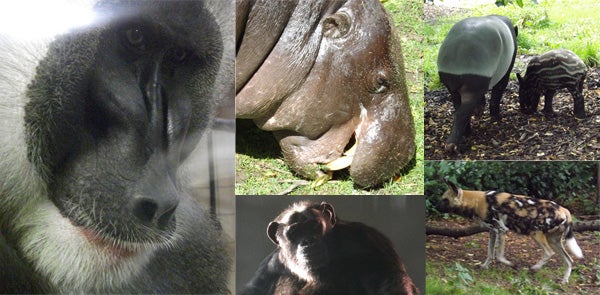
A montage of Edinburgh Zoo mammals mentioned in this article but not really discussed at length: Drill, Pygmy hippo, Malayan tapir, African hunting dog, Chimpanzee. Credit: DARREN NAISH
It’s modelled after Tierpark Hagenbeck in Hamburg and has an open design that incorporates landscaped gardens and wooded areas (no flowerbeds. Oh, how I hate flowerbeds). As is typical for zoos constructed prior to the modern era, several of the exhibits have (or had: read on) an archaic design and feel, being variously too cramped, too small or too ‘cagey’. However, several of the offending areas have been, or are being, revamped, and much of the zoo is spacious and well designed. More on these issues below.
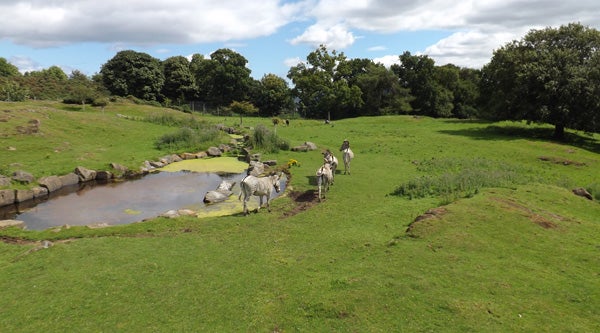
Green, spacious enclosure for hoofed mammals (seen from elevated walkway with viewing platforms). Credit: DARREN NAISH
Edinburgh Zoo is extremely popular, being Scotland’s second most popular paying visitor attraction (only Edinburgh Castle is ahead of it. Free attractions, like Loch Ness, are not counted here). I’ve visited at the height of summer at least twice (as well as during the depths of winter) and have never been driven too mad by the throngs of children or long queues – there is enough space, and enough in the way of eateries and cafes and so on that things are never that bad.
Penguins, koalas, giant pandas. Several highlights make Edinburgh Zoo nationally famous. Namely, the penguins (which have been a staple ever since 1913), Koala Phascolarctos cinereus, Giant panda Ailuropoda melanoleuca and Malayan sun bear Helarctos malayanus. No other UK zoo currently houses koalas or giant pandas.
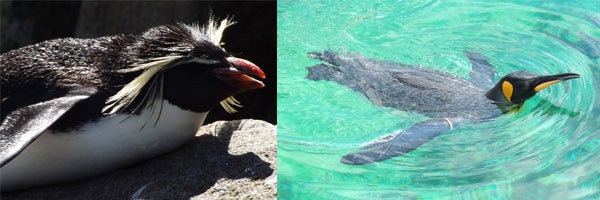
Penguins of Edinburgh Zoo: Rockhopper at left, King penguin at right. Credit: DARREN NAISH
The penguin enclosure is well designed, open and spacious, with viewing available from most sides. A central bridge allows people to walk out over the pool and adjacent to places where penguins are resting or lounging. The penguins actually leave their enclosure and embark on a daily ‘parade’ nearby, guided of course by keepers (the zoo emphasises that participation is voluntary and that the birds are not bribed with food or anything like that). As of right now, they have three species (King Aptenodytes patagonicus, Gentoo Pygoscelis papua and Rockhopper Eudyptes chrysocome). There’s also a nesting area, nest-cams, and an unusual pale Gentoo penguin called Snowflake. And there’s a Gentoo (or maybe it’s more than one) that seems obsessed with moving shadows cast by visitors, though I’m pretty sure this is a widespread penguin trait.
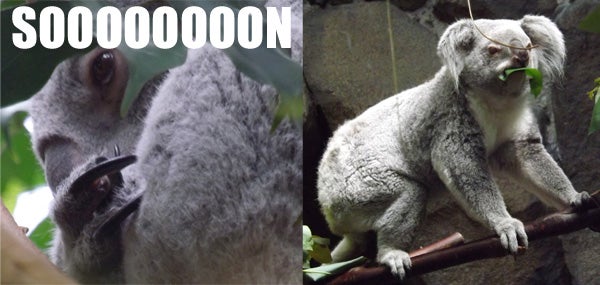
The only (live) koalas I've ever seen have been these ones in Scotland. Credit: DARREN NAISH
The koalas are in a modern, spacious house with numerous information panels and glass (rather than mesh) separating visitors from animals. Attendants are there to keep visitor noise to a minimum and provide information. Similar things can be said about the Giant pandas: they also have a new, well designed, oriental-style building with both indoor and outdoor viewing sections. You can’t just show up at the panda exhibit and wander in: it has a special ticketing system whereby you book a slot on arriving. This is all understandable and sensible in view of the popularity of these animals. Also understandable is that visiting Giant pandas is very much a hit and miss affair. On my most recent visit (July 2016), entry to the house was not permitted, and the pandas were asleep indoors, making viewing things from the outside a waste of time. But… you shouldn’t go to a zoo and expect to see all the animals all the time. They’re animals, not animatronics.
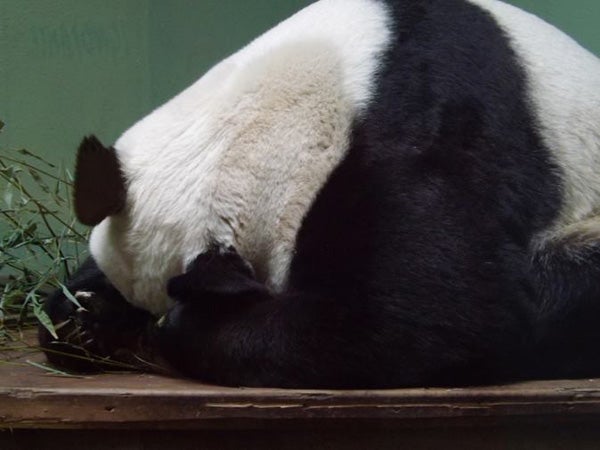
No Giant pandas for me in July 2016, but here's one I saw in 2015. It's asleep, but what a privilege to see one. Credit: DARREN NAISH
Reminder to self: write an article on that misplaced ‘Giant pandas are evolutionary failures’ claim some time. It’s such a poor argument.
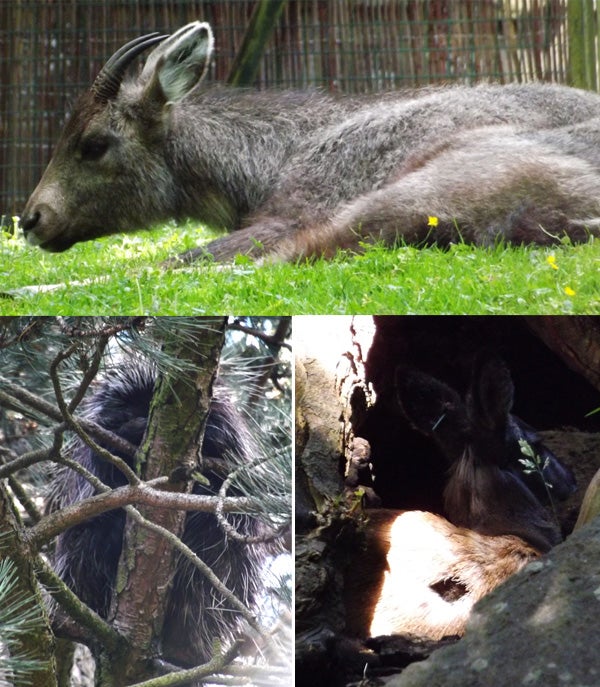
A few mammals you might not have seen in captivity before: Chinese ghoral (at top), North American porcupine (lower left, asleep and hiding its face), Siberian musk deer hiding inside a hollow tree (lower right: what's with that dark patch on its back? It's not close to the tail, nor is it the fabled musk gland itself). Credit: DARREN NAISH
Obscure and excellent. Moving on, Edinburgh Zoo has several other animals that are not seen all that frequently in captivity, including Drill Mandrillus leucophaeus, Chinese ghoral Naemorhedus caudatus, Binturong Arctictis binturong, North American porcupine Erethizon dorsatum and Siberian musk deer Moschus moschiferus (photos of all shown here).
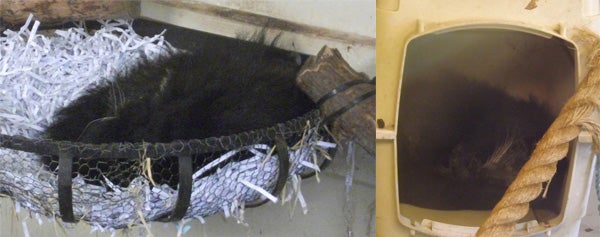
At left: Binturong asleep in a nest, 2015. At right: Binturong asleep in a box, 2016. Credit: DARREN NAISH
Frustratingly, the Binturong seems to be perpetually asleep – at least, it has been on the several times I’ve gone to see it. What this means for naïve visitors is that they simply get to see a dark furry lump asleep in a box (or in the hammock-like shelf also in the enclosure), and leave with no clue as to what a Binturong is or should be (and I’m sure I don’t need to remind you that people hardly ever read signage). I therefore wish that the alternative name Bear-cat was written in big letters somewhere: at least then people would be more interested, perhaps enthused. But I'm not dissing the signage – more on that below. Oh, waitaminute, maybe the sign DOES say that the animal is also known as a Bear-cat (and the sign also has a great photo of the animal in active pose)... never mind.
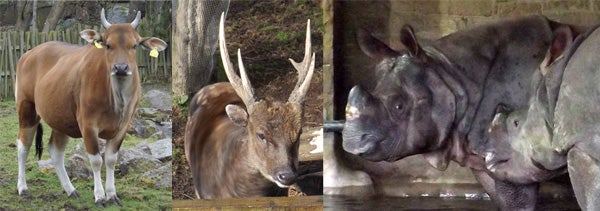
Hoofstock at Edinburgh Zoo, photographed in early 2015. Left to right: Banteng, Visayan spotted deer (note blurry body: the animal was in the middle of shaking water from its coat), Great one-horned rhino (animal on right was prodding his brother to get out of the water). Credit: DARREN NAISH
For me, the zoo is especially strong for two additional reasons. The first is hoofstock: there are several large grassy enclosures stocked with interesting and attractive hoofed mammals, and smaller enclosures throughout the zoo are home to such creatures as Malayan tapir Tapirus indicus, Southern pudu Pudu pudu, Kirk’s dik-dik Madoqua kirkii, Banteng Bos javanicus, Pygmy hippo Choeropsis liberiensis*, Red river hog Potamochoerus porcus and Visayan warty pig Sus cebifrons. On previous visits I’ve been thrilled to see Visayan spotted deer or Philippine spotted deer Rusa alfredi but they seemed not be there this time. I will of course admit that obscure tropical deer are something of a niche interest.
* To see why I’m using this generic name and not Hexaprotodon, see this recent Tet Zoo article in hippo history and evolution.
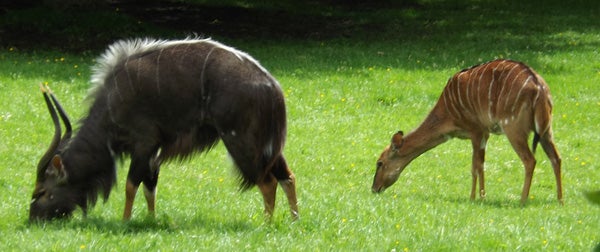
Lowland nyala at Edinburgh Zoo. It's... it's... almost as if there was some process by which males and females might end up looking quite different. I can't quite put a name on the process... Credit: DARREN NAISH
Those large grassy enclosures house Lowland nyala Tragelaphus angasii – one of those fantastically dimorphic antelopes with showy, elaborate males – as well as Grevy’s zebra Equus grevyi and Nile lechwe Kobus megaceros. There were Kiang or Tibetan wild ass Equus kiang at the zoo in 2013, but I didn’t see them this time round. The lechwe are relatively new and weren’t there the last time I visited (early 2015). The male seems to be a bit of a problem animal: the zebras were not thrilled with his presence and his horn-tips had been taped over. Anyway, the enclosure housing the zebra and lechwe is fantastic. Visitors are on a raised wooden walkway with viewing platforms and buildings, and you’re well above the heads of the animals and looking down on them. Do not drop your hat.
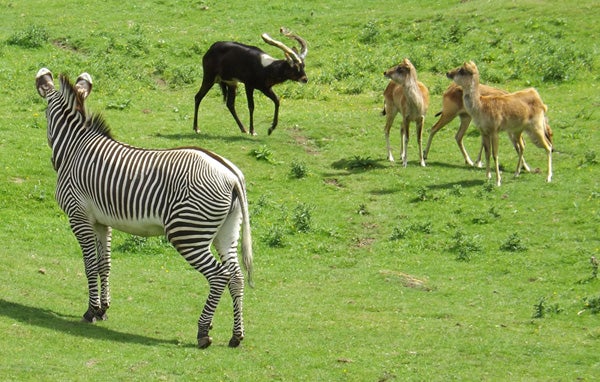
Grevy's zebra: "WHAT THE HELL is that?". Male and female Nile lechwe behind. Credit: DARREN NAISH
The second major strength is birds. Outdoor exhibits feature a set of charismatic megabirds (if you will), including storks and ibises, flamingos, ducks, pelicans, several pheasants (the Great argus Argusianus argus seemed not to be on display), Darwin’s or Lesser rhea Rhea pennata and, your favourite and mine, Southern or Double-wattled cassowary Casuarius casuarius. The zoo’s cassowary – I think called Sydney or Sidney – is sometimes hard to spot, but I learnt that’s because he/she sits in a corner, concealed behind vegetation but easy to get close to if you know where to look. On a 2015 visit I managed to get up close and personal to this bird since crappy weather had driven it indoors where it spent most of the day standing right next to a viewing window.
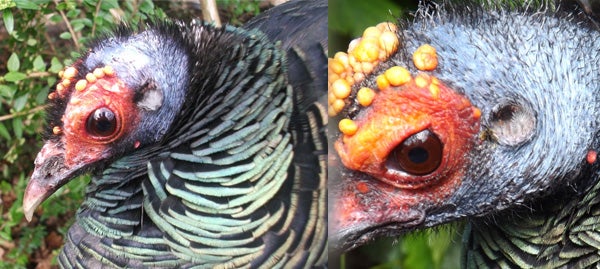
The same friendly Ocellated turkey Meleagris ocellata, photographed (at left) in 2015, and (at right) in July 2016. Notice how the ornaments have increased in size and number. Credit: DARREN NAISH
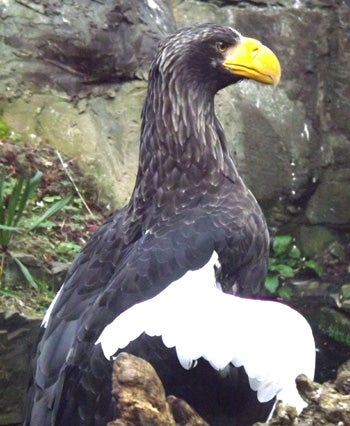
Awesome Steller's sea eagle (this is the larger female) at Edinburgh Zoo in 2015. I don't think they have this species at the zoo right now. Credit: DARREN NAISH
On the subject of charismatic megabirds, the zoo did have two Steller’s sea eagles Haliaeetus pelagicus which I much enjoyed watching on a previous visit. They now seem to have gone, macaques now occupying the large, tall enclosure. Snowy owls Bubo scandiacus were on show this time. Much as I like them, they’re now so familiar (curse you, J. K. Rowling) that I didn’t feel the need to look at them again. Favourite Snowy owl fact: it’s a large, white, cold-adapted member of the eagle owl lineage that has secondarily lost ear tufts.
Then there’s the Brilliant Birds exhibit, opened in 2011. This is a walk-through tropical aviary, planted and landscaped to look something like a tropical forest. The significance of the zoo as goes its role in conservation is highlighted by the successful breeding here of Bali starling Leucopsar rothschildi and Socorro dove Zenaida graysoni, a species extinct in the wild since 1972. The exhibit is heavy on columbiforms, also featuring Victoria crowned pigeon Goura victoria, White-naped pheasant pigeon Otidiphaps aruensis, Pied imperial pigeon Ducula bicolor and Nicobar pigeon Caloenas nicobarica. Numerous other species are on show as well. Kudos to the man working in the house on the day I was there: he really knew his birds and knew how to correct people (“No, it’s not a turkey, it’s a kind of pigeon”) without making them look silly in front of their children.
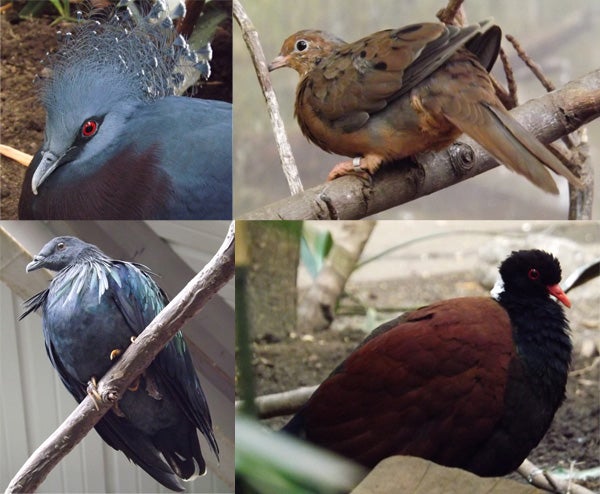
How much columbiform awesome can one zoo hold? All of these species AND MORE are currently on display in the Brilliant Birds exhibit. Clockwise from top left: Victoria crowned pigeon, Socorro dove, White-naped pheasant pigeon, Nicobar pigeon. I didn't once use the term "close kin of the Dodo". Oh, damn. Credit: DARREN NAISH
The defunct ‘Big Cat Walkway’ is no more. I should also say that there was – until recently – a third thing that might be regarded as an Edinburgh Zoo highlight. This was the whole walkway of carnivoran* enclosures – the so-called Big Cat Walkway – which again featured species not frequently seen in captivity, including Wolverine Gulo gulo, Pallas’s cat Otocolobus manul and Asian golden cat Catopuma temminckii. An Amur leopard Panthera pardus orientalis and black Jaguar Panthera onca were there too (on a previous visit this animal repeatedly came up close to the glass, vocalising all the while), and also European wildcat Felis silvestris.
* The frustrating ambiguity that surrounds the term ‘carnivore’ (are we referring to any organism that eats animal matter, or specifically to a member of the mammal group Carnivora?) means that it’s better to use the unambiguous term ‘carnivoran’ when referring to members of Carnivora. This has yet to catch on in the zoo and conservation worlds but is now fairly standard in the literature on systematics and evolutionary biology.
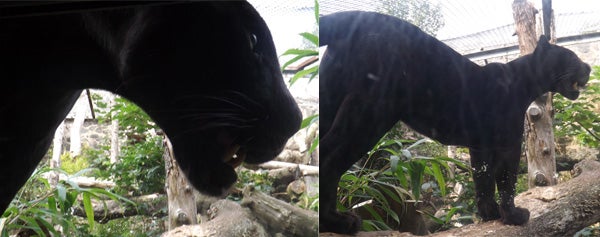
This images show how close you could get to the carnivorans along the now defunct 'Big Cat Walkway'. This black Jaguar was prowling back and forth and making a lot of noise while I was taking these photos (early 2015). Credit: DARREN NAISH
Sadly, these 1920s-style enclosures – while nicely landscaped and planted with an appropriate amount of vegetation – were never large enough and essentially amounted to small concrete-walled pens with mesh roofs and claustrophobically framed glass fronting. As much as I wanted to see a Wolverine, Asian golden cat and so on (this time with a half-decent camera), I was not, therefore, unhappy to see that this section had been scrapped. Actually, the enclosures are still there, but now concealed behind signage. The Wolverine formerly on display is now at the Highland Wildlife Park in Cairngorms National Park.
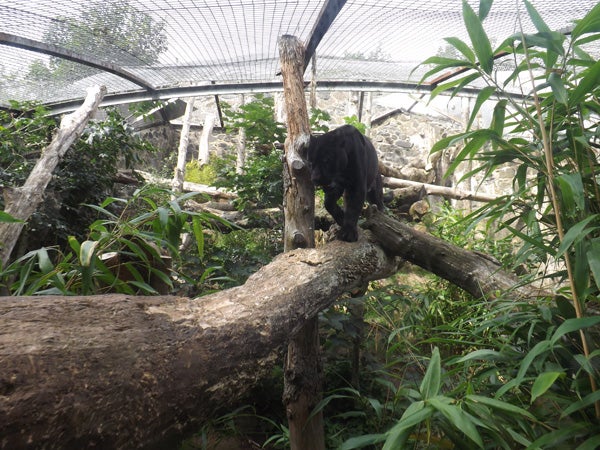
This isn't a bad looking enclosure... but it's obviously way too small for an animal like a Jaguar. It's no longer in use. Credit: DARREN NAISH
Of the ‘Big Cat Walkway’ enclosures, an expanded European wildcat exhibit is the only one left. It is, of course, appropriate to have a large wildcat enclosure at the zoo given that Scotland is the only part of the UK where this species remains (historically, it occurred nationwide) – this explains why F. silvestris is typically (but, technically, incorrectly) termed ‘Scottish wildcat’ by British naturalists. On the subject of cats, the zoo is also home to an Asiatic lion P. leo persica pair. They are popular enough that there was a substantial queue merely to see them sleeping indoors – I and my companions gave up, but I came back later and got good views of both animals outside.
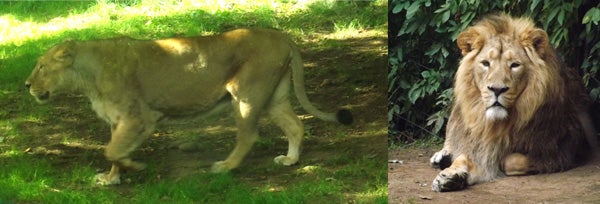
Asiatic lion pair at Edinburgh Zoo, photographed years apart. The books say that males have a less impressive mane than African lions. Oh really? Credit: DARREN NAISH
Budongo Trail and much else. There’s much else that I haven’t discussed here, including a wallaby walkway, the Living Links primate exhibit (featuring squirrel monkeys and capuchins) and a very impressive, innovative, recently opened chimpanzee-themed exhibit called the Budongo Trail (it has a lecture theatre, interactive displays, impressive art, and describes links with conservation programmes in the Budongo Forest in Uganda). There are other primates in addition to those mentioned so far, including geladas, gibbons and guenons (there are not any orangutans there today, despite the statue mentioned below).
There is in fact so much to see that, despite spending a whole day at the zoo on my most recent visit, I didn’t get to see the chimps. I did see them in 2015, however. A Sumatran tiger exhibit is being constructed at the time of writing.
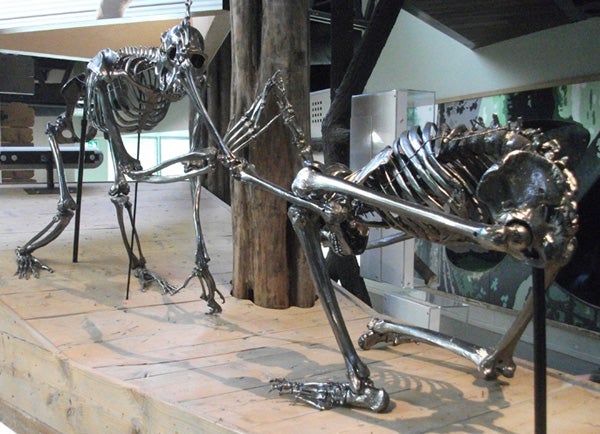
Impressive and moving installation in the Budongo Trail building: a hominin (at right) bows in reverence to the Pan at left. Any zoo that puts this much thought and effort into its surrounds knows what it's doing. Credit: DARREN NAISH
Statues, art, metalwork, signage. Finally, I’m a big fan of the artwork you often get at zoos – at statues, murals, paintings and so on. Edinburgh Zoo is pretty good on these. The koala enclosure features artwork recalling that of indigenous Australians, I like Russell Dempster’s painting depicting the primate family tree (the idea is that you take the role of token human, and stand in appropriate place on the tree), wrought ironwork depicts the original denizens of various of the enclosures, and there’s a giant statue of an orangutan family, erected in 1942 to celebrate the first breeding of orangs in the UK (though, sadly, none of the three babies survived).
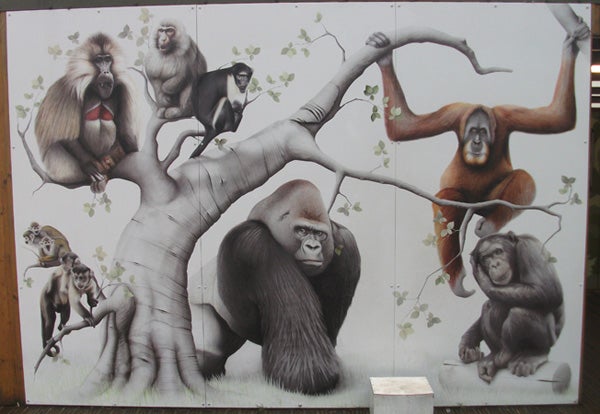
Excellent installation (painting by Russell Dempster) depicting anthropoid primate family tree - you stand in place and get your photo taken. Of course, some people joke about the fact that the orang is revealing the incorporation of DNA from a wholly different lineage... Credit: DARREN NAISH
Especially famous is the statue of Sir Nils Olav, a King penguin who served as mascot and Colonel-in-Chief of the Norwegian King’s Guard. He died in 1987, his rank then being adopted by Nils Olav II. The latter was awarded a knighthood in 2008. I’ve written about the use of goats as military mascots before – see the article here – but not penguins.
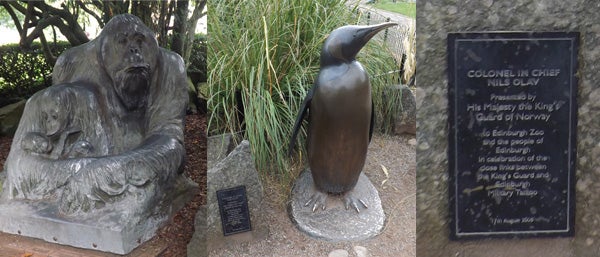
Statues at zoos are frequently fascinating and deeply relevant to the history of the zoo and its animals, staff and founders. At Edinburgh Zoo, we have a statue celebrating the 1942 breeding of orangutans, and one of Sir Nils Olav, Colonel-in-Chief of the Norwegian King’s Guard. Credit: DARREN NAISH
I’ve mentioned signage once or twice in this article. While people so often seem reticent to pay attention to them – many people seem to prefer to guess blindly about animals at zoos rather than glance to the side and spend a few seconds reading (see #StuffHeardAtZoos on twitter for more on this) – signs at zoos range from the useless to the outstandingly good. Edinburgh Zoo is pretty good – the signs are obvious, they feature attractive colour illustration of the animals, they’re consistent in format, and they contain useful and accurate information. So, overall, things are good.
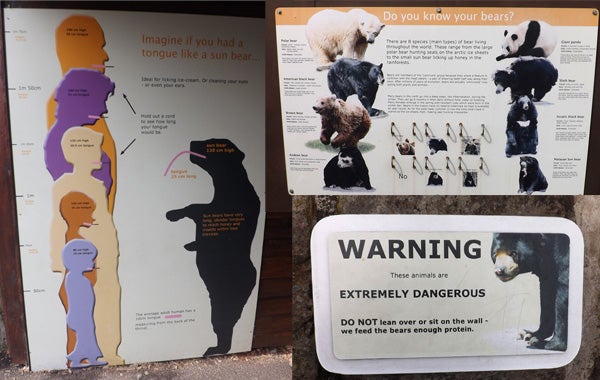
The signs at Edinburgh Zoo are impressive, informative, and well designed. They also include some humour: the one at bottom right says "DO NOT lean over or sit on the wall - we feed the bears enough protein". Credit: DARREN NAISH
Wrapping it all up. And that just about wraps up everything I want to say. Edinburgh Zoo is, as I’ve said, stuck with some old and less than ideal exhibits and enclosures in a few places, but by and large it’s doing its best to change and is mostly well designed (albeit hilly). It’s more modern sections – the grasslands featuring the lechwe and zebras, the Budongo Trail, the Living Links centre, the Brilliant Birds exhibit, the Koala and Giant pandas houses and so on – are all outstandingly good and will make you happy. The famous penguin section is also fabulous. Signage is good, the selection of animals is outstanding, and the zoo is clearly invested in good conservation work and does its best to remind visitors of this.
In what I aim to be a regular thing, I’ll finish by rating the zoo in my own subjection fashion…
Selection of species: 9 out of 10
Zoo nerd highlights: Koala, Giant panda, Binturong, cassowary, Great one-horned rhino, diverse pigeons
Size and quality of enclosures: 8 out of 10
Quality of signage: 9 out of 10
Value for money: 10 out of 10
Overall worthiness: 10 out of 10
For previous Tet Zoo articles relevant to various of the topics mentioned or discussed here, see...